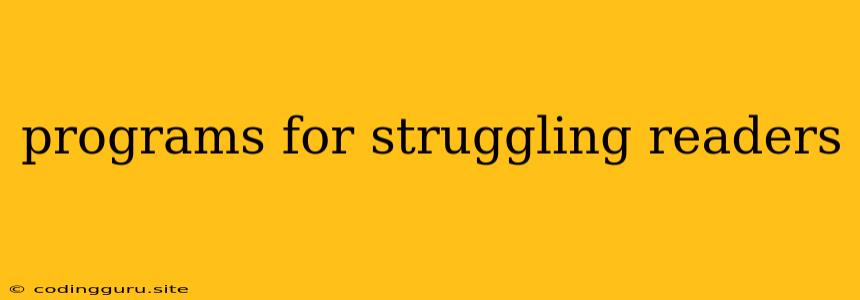Struggling with Reading? Here are Programs to Help
Reading is a fundamental skill that forms the basis of learning and communication. However, many individuals face difficulties in reading, leading to frustration and challenges in their academic and personal lives. Fortunately, numerous programs and interventions exist to address reading difficulties, offering hope and support for struggling readers of all ages.
Understanding Reading Difficulties
Before exploring specific programs, it's crucial to understand the nature of reading difficulties. These can arise from various factors, including:
- Phonological Awareness: This refers to the ability to recognize and manipulate sounds in spoken language. Difficulty in this area can hinder the development of reading skills, as it impacts decoding and word recognition.
- Decoding: This involves breaking down words into their individual sounds and blending them together to pronounce the word. Struggling readers may have difficulty in this process, leading to slow and inaccurate reading.
- Fluency: Fluent readers read smoothly and automatically, with good comprehension. Struggling readers may read slowly, word by word, with poor intonation and expression.
- Comprehension: This refers to the ability to understand the meaning of what is being read. Reading difficulties can hinder comprehension, as students struggle to make connections and draw inferences.
Programs for Struggling Readers: A Comprehensive Overview
Numerous programs are designed to address reading difficulties and enhance reading skills. These programs vary in their approaches, target age groups, and specific areas of focus.
1. Phonics-Based Programs:
- Focus: These programs emphasize the relationship between letters and sounds, teaching children to decode words by identifying the sounds that individual letters or letter combinations represent.
- Examples: Jolly Phonics, Orton-Gillingham, Wilson Reading System
- Benefits: These programs are highly effective in building foundational reading skills, particularly for students with dyslexia or other specific learning disabilities.
2. Multisensory Programs:
- Focus: These programs engage multiple senses, such as vision, hearing, and touch, to improve reading skills. They often incorporate hands-on activities, games, and visual aids.
- Examples: Slingerland and Project Read
- Benefits: These programs can be helpful for students with a variety of learning difficulties, as they provide a multi-faceted approach to learning.
3. Computer-Assisted Reading Programs:
- Focus: These programs use technology to deliver interactive lessons, track progress, and provide individualized instruction. They often incorporate adaptive learning features, adjusting the difficulty level based on the student's performance.
- Examples: Reading Eggs, Starfall, Lexia
- Benefits: Computer-assisted programs offer flexibility, engagement, and personalized learning experiences, making them an effective tool for struggling readers.
4. Tutoring Programs:
- Focus: One-on-one or small group tutoring provides individualized support and guidance, addressing specific reading challenges.
- Examples: Reading Recovery, Supplemental Instruction, After-school tutoring programs
- Benefits: Tutoring provides personalized attention, addressing individual needs and tailoring instruction to specific areas of difficulty.
Tips for Choosing the Right Program
Selecting the right program for your child or student is essential. Here are some tips for choosing a program:
- Assess Individual Needs: Identify the specific reading difficulties your child or student faces. Is it decoding, comprehension, fluency, or a combination?
- Consider Age and Developmental Level: Choose a program that is age-appropriate and aligned with the student's cognitive and reading abilities.
- Seek Professional Guidance: Consult with a teacher, reading specialist, or educational psychologist for recommendations and guidance on program selection.
- Trial Periods: If possible, take advantage of trial periods or free demos to see how the program engages your child or student.
- Consider Cost and Accessibility: Factor in the cost and availability of the program, ensuring it fits within your budget and can be accessed conveniently.
Supporting Struggling Readers at Home
Parents and caregivers can play a significant role in supporting struggling readers. Here are some strategies:
- Create a Positive Reading Environment: Make reading a fun and engaging activity, encouraging your child to read regularly and explore different genres.
- Read Aloud: Reading aloud exposes your child to fluent reading and expands vocabulary.
- Play Word Games: Engage in word games and activities that enhance phonological awareness and vocabulary development.
- Collaborate with Teachers: Communicate with your child's teacher to stay informed about their progress and discuss strategies for supporting their reading development.
Conclusion
Numerous effective programs exist to address reading difficulties, providing hope and support for struggling readers. Choosing the right program, based on individual needs and specific challenges, is crucial for success. By providing targeted interventions and creating a supportive learning environment, we can help struggling readers overcome their challenges and reach their full potential. Remember, reading is a fundamental skill that unlocks a world of knowledge and possibilities. With the right support and resources, all students can achieve reading success.
